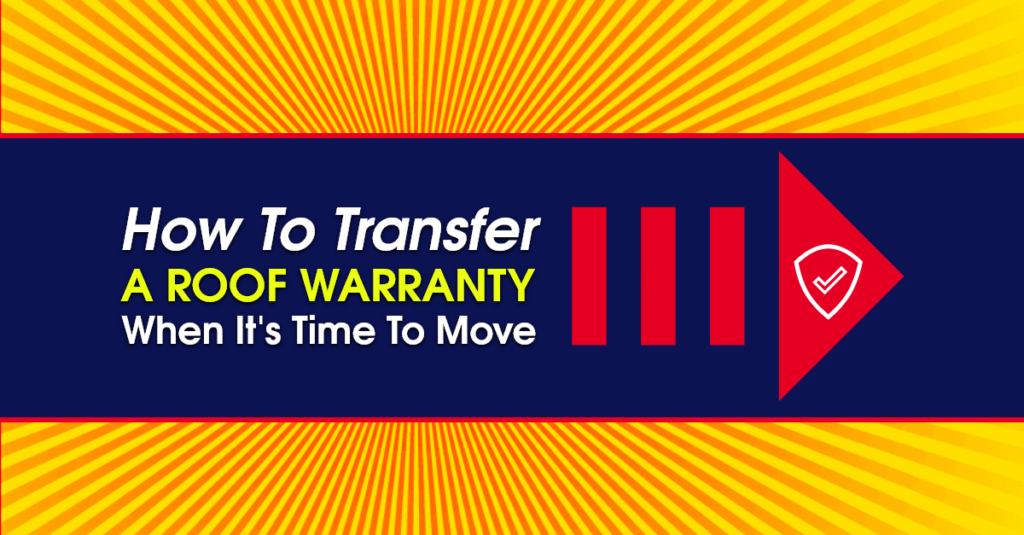How to Transfer a Roof Warranty
During a real estate transaction, it’s worth looking at the roof warranty. Roofs are one of the largest and most expensive home improvement projects, and a quality roof that lasts for many years can boost your home’s value.
Whether you’re buying or selling a home, the transferability of your roof warranty could motivate the sale. For a seller, a transferable warranty could attract the right buyers and add value to the home. For a buyer, knowing that the roof is in excellent condition and has an active warranty might provide some peace of mind on their investment. Check out the information below on how to transfer a warranty.
Roof Warranties – What Are They?
A roof warranty is a written guarantee of the quality and integrity of a product and of the manufacturer’s responsibility to fix or replace any defective parts that fail within a certain period of time. The key word here is defective – warranties do not cover problems caused by aging, acts of nature, normal wear and tear, or neglect.
When installing a new roof, you should receive two written roof warranties: one from the roofing contractor and another from the manufacturer of the roofing products installed.
Manufacturer’s Warranty
Most residential roofing materials come with a basic limited lifetime warranty from the manufacturer. A standard manufacturer’s warranty generally protects only the roofing materials.
If the product is found to be defective during a specific period, the manufacturer will give your replacement roofing materials at no extra cost. However, this is on condition that the roofing contractor installed the roofing materials following the manufacturer’s installation procedures.
Standard manufacturer warranties do not cover the costs for removing and disposing of failed materials or labor costs for installing the new materials.
Occasionally, with extended manufacturer warranties, the contractor’s labor is also included in the warranty.
A manufacturer’s warranty is final and cannot be changed by the contractor or the homeowner.
Workmanship Warranties
A workmanship warranty covers the quality of installation. If your roof fails because of installation errors, a roofing contractor’s workmanship warranty will cover the cost of labor and materials needed to fix or replace the failing roof.
A reputable roofing contractor should stand behind their promises of quality workmanship. Workmanship warranties usually go from 2 to 25 years, depending on the contractor. The manufacturer has no say in the length of your workmanship warranty.
Can You Transfer Your Roof Warranty?
Warranty terms and transfer rules vary widely among manufacturers and even among the product line a manufacturer sells. Whether or not the warranty is transferable is spelled out in the contract, so you’ll want to pay close attention to your warranty’s terms.
Some manufacturers do not provide transferable warranties; some might transfer once or twice. Other manufacturers allow their warranties to be transferred as often as the home’s ownership changes during the warranty period.
Most roofing manufacturers, however, provide transferable warranties for their roofing products. However, most of these coverages only allow a one-time transfer. If you’re the one who installed the roof, you can transfer the warranty to the homebuyer, allowing them to receive the benefits of that warranty.
But if the new homeowner decides to sell the home again within the warranty’s active period, it isn’t guaranteed that the warranty will still be transferable to the next owner.
Aside from transferable manufacturer warranties, roofing contractors also provide workmanship warranties. But are these warranties transferable? With StormForce of Jacksonville, they are. Our workmanship warranties are tied to the address, not the homeowner, meaning they can be transferred when there’s a change in property ownership.
When selling your home, having a roof warranty that can be transferred to the new owner can be an attractive selling point.
How to Transfer a Roof Warranty to the New Homeowner
Proper record-keeping can make the transfer process relatively simple. After your roof installation. It’s important to securely store the copy of the warranty, along with other necessary paperwork.
Transferring the roof warranty should start when the real estate transaction is underway. Here are key things you need to know and do to ensure property roof warranty transfer:
Notify the manufacturer: You’ll need to notify the manufacturer and the contractor about the change in ownership. All the required paperwork and transfer requests must be submitted within a specific time frame after the real estate transaction’s closing.
Installation date and proof of purchase: A roof warranty coverage is based on the installation date, so you need to know when your roof was installed. If the prior owner lost the original warranty documents, you might have to contact the roofing contractor and request a copy of the agreement.
Evidence of ownership: Proof of ownership information can be found through building permits or the county’s website. Other documents you may use include a copy of the deed or closing documents showing the names of the prior property owner and the new owner and the date of the property transfer.
Administrative fee: There may be fees associated with roof warranty transfer to the new owner.
Procedures for transferring roof warranties are pretty variable, so you want to read the fine print and talk with your roofing contractor.
You can rely on StormForce for your roofing needs in Jacksonville, Florida. As a GAF Master Elite roofing contractor, we use the finest roofing products and installation procedures to ensure quality. Our reliable roofing experts will help you pick the best GAF warranty protection level for your needs and install a new roof. We also offer competitive labor warranties for roof repair and replacement.
If you have any questions about our roofing services or roof warranties, contact us today.
